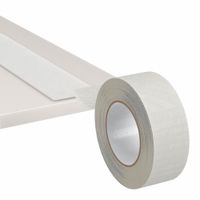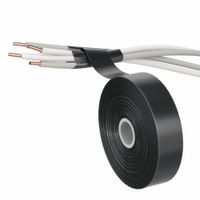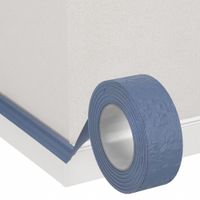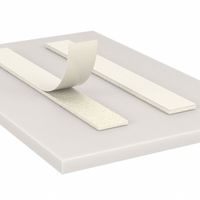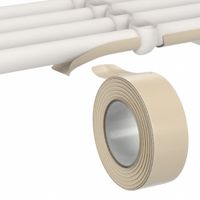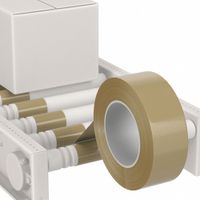Call +(254) 703 030 000 / 751 483 999 / 721 704 777
.....Read More
Frequently Asked Questions
What are the different types of adhesive tapes available?
There are many different types of adhesive tapes available, each designed for specific purposes and applications. Some common types include: * **Pressure-Sensitive Tapes (PSTs):** These tapes adhere with light pressure and do not require heat, water, or a solvent for activation. Examples include:
* **Packaging Tapes:** Used for sealing boxes and cartons, often made of polypropylene or PVC with acrylic or hot melt adhesive.
* **Masking Tapes:** Typically made of paper, used for masking off areas during painting or other applications where a clean edge is required.
* **Duct Tapes:** Strong, fabric-backed tapes with a rubber-based adhesive, used for various repairs, sealing, and bundling.
* **Electrical Tapes:** Made of PVC, designed to insulate electrical wires and connections.
* **Double-Sided Tapes:** Coated with adhesive on both sides, used for bonding two surfaces together. They can be foam-backed for irregular surfaces or thin film for smooth ones.
* **Medical Tapes:** Hypoallergenic tapes used for wound dressings, securing medical devices, and other healthcare applications.
* **Water-Activated Tapes (WATs):** These tapes have a dry adhesive that becomes sticky when moistened with water, commonly used for carton sealing.
* **Heat-Activated Tapes:** These tapes require heat to activate their adhesive, often used in industrial bonding applications.The choice of adhesive tape depends on factors such as the surfaces to be bonded, environmental conditions, required strength, and duration of adhesion.
How do I choose the right tape for my application?
Choosing the right tape depends on several factors, including the application, the surfaces involved, environmental conditions, and required strength. Different types of tapes are designed for specific purposes. For example, masking tape is suitable for temporary adhesion and painting, while duct tape offers strong, versatile adhesion for repairs. Electrical tape provides insulation, and double-sided tape is ideal for mounting. Consider factors like indoor or outdoor use, temperature extremes, moisture exposure, and the weight or stress the tape needs to withstand. Understanding these variables will help you select the most effective and durable tape for your specific needs.
What surfaces can adhesive tape stick to?
Adhesive tape can stick to a wide variety of surfaces due to the properties of its adhesive. The effectiveness of the bond depends on several factors, including the type of adhesive, the surface energy of the material, its texture, and cleanliness.
Common surfaces that adhesive tape adheres well to include: * **Smooth, Non-Porous Surfaces:** Glass, metal, smooth plastics (like acrylic or PVC), and ceramics generally provide excellent adhesion because they allow for good contact between the adhesive and the surface, maximizing the intermolecular forces (Van der Waals forces) responsible for adhesion.
* **Painted or Sealed Wood:** If the wood surface is smooth, clean, and properly sealed or painted, adhesive tape can form a strong bond.
* **Paper and Cardboard:** These fibrous materials are widely used with various types of tapes, from office and masking tapes to packaging tapes. The tape adheres by mechanically interlocking with the fibers and through surface energy interactions.
* **Certain Fabrics:** While adhesion can vary greatly depending on the fabric's weave and material, some tapes are designed for temporary or permanent adhesion to textiles.Surfaces that can be challenging for adhesive tape include: * **Rough or Porous Surfaces:** Concrete, unsealed wood, or highly textured plastics can reduce the contact area between the adhesive and the surface, leading to weaker bonds.
* **Low Surface Energy Materials:** Materials like silicone, Teflon (PTFE), and some waxy plastics are naturally non-stick, making it difficult for most adhesives to wet out and form strong bonds.
* **Dirty or Oily Surfaces:** Contaminants like dust, grease, oil, or moisture create a barrier between the adhesive and the surface, preventing proper bonding.
* **Powder-Coated or Textured Paints:** These finishes can reduce the effective contact area for the adhesive.For optimal adhesion, surfaces should ideally be clean, dry, and free of contaminants. Different types of adhesive tapes (e.g., acrylic, rubber-based, silicone) are formulated to work best with specific surface types and environmental conditions.
How do I remove adhesive tape without leaving residue?
Removing adhesive tape without leaving residue can be achieved with several methods, depending on the type of surface and adhesive. For most surfaces, starting with gentle heat can soften the adhesive, making it easier to peel off. A hairdryer on a low setting, held a few inches away, can work well. Once the tape is removed, any remaining residue can be tackled.
Common household products often work effectively. Rubbing alcohol (isopropyl alcohol) is excellent for non-porous surfaces like glass, plastic, or metal; simply apply a small amount to a cloth and gently rub the residue away. Vinegar is another option, particularly for older, hardened residue; a solution of equal parts water and vinegar can be applied and allowed to sit for a few minutes before wiping. For delicate surfaces, or if you're unsure, try a small, inconspicuous area first.
Specialized adhesive removers are also available and can be very effective, especially for stubborn residues. These products are formulated to break down the adhesive without damaging the surface. Always follow the product's instructions and ensure good ventilation when using chemical removers. For very delicate surfaces or if the residue is extensive, it may be best to consult a professional or a specialist cleaning service.
What is the difference between single-sided and double-sided tape?
Single-sided tape has adhesive on only one side of its backing material, making it suitable for applications where you need to attach one surface to another or seal an item. Common uses include sealing boxes, labeling, masking, and general repairs.
Double-sided tape, conversely, features adhesive on both sides of its backing material. This design allows it to bond two surfaces together, creating a strong, often invisible, connection. It's frequently used for mounting, crafting, scrapbooking, carpet installation, and in various industrial applications where a discreet and strong bond is required. The choice between single-sided and double-sided tape depends entirely on the specific application and whether you need to adhere to one surface or join two surfaces together.
Can adhesive tape be used outdoors?
Adhesive tape can be used outdoors, but its effectiveness depends heavily on the type of tape and the environmental conditions. Standard indoor tapes are not designed to withstand outdoor elements like moisture, UV radiation, extreme temperatures, and dirt, which can quickly degrade the adhesive and backing, leading to failure.
For outdoor applications, tapes specifically designed for these conditions are essential. These often feature strong, weather-resistant adhesives, such as acrylic or rubber-based formulations, that maintain their bond across a wide temperature range and resist breakdown from UV light and moisture. The backing material is also crucial; outdoor tapes frequently use durable materials like polyethylene (PE), vinyl, or fabric, which are resistant to tearing, abrasion, and water absorption.
Common outdoor applications for adhesive tape include temporary repairs, sealing drafts, bundling items, and marking. When selecting an outdoor tape, consider the expected exposure to sunlight, rain, humidity, and temperature fluctuations. For instance, a tape used for a permanent outdoor seal on a building will need a higher level of weather resistance than one used for a temporary repair on a garden hose. Always ensure the surface is clean, dry, and free of debris for optimal adhesion.
How do I store adhesive tape to maintain its effectiveness?
To maintain the effectiveness of adhesive tape, proper storage is crucial. The primary factors to consider are temperature, humidity, and exposure to light and contaminants.
Ideally, adhesive tape should be stored in a cool, dry environment with a consistent temperature, typically between 60°F and 80°F (15°C and 27°C). Extreme temperatures, both hot and cold, can degrade the adhesive over time. High heat can cause the adhesive to soften and lose its tack, while cold temperatures can make it brittle and reduce its initial adhesion.
Humidity also plays a significant role. High humidity can cause the adhesive to absorb moisture, leading to reduced tack and potential delamination. Conversely, extremely low humidity can dry out some adhesives, making them less pliable. A relative humidity of 40% to 60% is generally recommended.
Direct sunlight and UV light exposure should be avoided as they can break down the adhesive and backing materials, causing discoloration and a loss of adhesive properties. Store tape in its original packaging or in opaque containers to protect it from light.
Furthermore, keep tape away from dust, dirt, oils, and other contaminants that can settle on the adhesive surface and impair its performance. Storing rolls upright in dispensers or on mandrels can help prevent edges from flattening or getting damaged.
Following these guidelines will help ensure the tape retains its intended adhesion and performance characteristics for its full shelf life.
What are the best practices for applying adhesive tape?
For optimal adhesion and performance of adhesive tape, several best practices should be followed. First, ensure the surface is clean, dry, and free of dust, oil, grease, or any contaminants. Pre-cleaning with appropriate solvents like isopropyl alcohol can be beneficial. Second, consider the temperature and humidity of the environment. Most tapes have an optimal application temperature range; applying outside this range can affect bond strength. Third, apply the tape with firm, uniform pressure to ensure maximum contact between the adhesive and the surface. A squeegee or roller can help eliminate air bubbles and achieve a strong bond. Fourth, allow sufficient dwell time for the adhesive to fully bond. The adhesive strength typically increases over the first 24-72 hours. Finally, when cutting the tape, use a sharp blade to prevent fraying and ensure a clean edge, which contributes to a neater and more secure application.
How long does adhesive tape last once applied?
The lifespan of adhesive tape after application can vary significantly based on several factors, including the type of adhesive, the surface it's applied to, environmental conditions, and the quality of the application. Generally, for everyday household uses, common tapes like masking tape or cellophane tape might last from a few days to a few months before losing their adhesion or becoming brittle.
More specialized tapes, such as industrial-grade tapes, duct tapes, or electrical tapes, are designed for greater durability and can last for years, especially in controlled environments. Factors like exposure to sunlight (UV radiation), extreme temperatures, humidity, and chemical exposure can degrade the adhesive over time, shortening its effective life. A clean, dry, and smooth application surface is also crucial for maximizing the tape's longevity. Some tapes are specifically formulated for outdoor use or high-stress applications and will naturally have a longer post-application lifespan than general-purpose tapes.
Are there specific dispensers for different types of tape?
Please tell me what you would like me to elaborate on.
